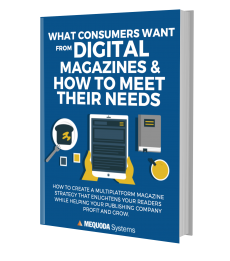Multimedia publishing demands multiplatform strategy, and Ebony is embracing it; plus, NYT latest to consider ad-free model
Multimedia publishing is remaking the industry, fueled by multiplatform strategy, content like video and podcasts, and an openness to experiment with events, ecommerce, and other components.
While one major brand is pursuing that course in being reborn, another all-time title is taking the drastic step of going with ad-free subscriptions.
Other news, as well, this week from MediaPost.com. Hope you had a great holiday weekend – let’s get started!
Ebony’s Multimedia Publishing Mission
Ebony’s new ownership sees major potential for this legendary brand, MediaPost.com reports.
“Ebony’s new owners are ready to set their plan in motion: turning a 71-year-old publication into a multimedia platform. Last week, Johnson Publishing Company, which has publishedEbony since 1945 and Jet since 1951, announced that African-American-owned private equity firm Clear View Group had acquired the titles. The new publishing entity, Ebony Media Operations, is Clear View’s first foray into print and digital publishing. According to a report by Ebony managing editor Madison J. Gray … Michael Gibson, who serves as board chair of Ebony Media Operations, and Willard Jackson, Clear View’s vice-chairman, want the new company to transform into a ‘multimedia platform,’ by expanding Ebony Media’s digital space and perhaps dip their toes into broadcast,” Sara Guaglione writes.
As Jackson said:
“We see bringing additional programs, activations, events, content … to further satisfy what we think is a need out there for African American content,” Jackson told Gray. “Whether it’s healthcare or education related, we want to offer different ways to provide content to the existing readership. We see really expanding the digital platform. We’re the No. 1 African American brand in the world,” he said. “It’s the power of the brand that we think sets us apart from all those other sites and digital platforms.”
New York Times Exploring Ad-Free Subscriptions
Recently, we relayed news of Rodale’s shift to ad-free magazines for Prevent, and explored whether this is a trend for digital publishers. Well, I think we can safely say yes now! The New York Times is planning such an endeavor, MediaPost.com reports.
The results are in: Discover how to make money with digital magazines, and launch a digital magazine that consumers actually want to buy, when you download our FREE 2016 Mequoda American Magazine Reader Study & Handbook and handbook today.
“The New York Times Co. CEO Mark Thompson revealed the plans during a panel hosted by the IAB at the Cannes ad festival on Monday, taking the opportunity to deliver a broadside against the ad-blocking companies. According to The Wall Street Journal, Thompson said the company is planning to offer subs that cost more than a regular digital subs. In return, users will ‘opt out of advertising if they want to do that’ — without violating the publisher’s terms of use agreement, as readers using ad blockers do,” Erik Sass writes.
“Thompson didn’t give a price tag for the planned ad-free subs. The basic sub currently on offer costs $2.63 per week for the first year and $3.75 thereafter, for annual totals of around $137 and $195, respectively. … NYTCO hopes that offering ad-free subs will provide a simple, workable solution to an otherwise seemingly intractable problem.”
Premium Content Ad Placement Offers Superior Viewability
A new study is confirming what publishers promise advertisers: Better placement = better ROI.
Per MediaPost.com:
“According to the Teads study, readers looking at premium editorial content don’t scroll through as quickly as other types of content – presumably because they are actually paying attention to it. Therefore, they are more likely to see and engage with ads that appear alongside or in-stream in the article,” Sass writes.
“On average, users scrolled 50% faster through social media feeds than premium publisher sites. As a result, roughly nine in 10 readers looking at premium editorial content also viewed video ads appearing within the article, compared to six in 10 readers looking at social feeds. Similarly, users spent 24% more time looking at in-article video ads within premium content than they did looking at video ads in social feeds.”
Shareability Not Proportional to Readability?
Columbia University researchers and the French National Institute have released a study called “Social Clicks: What and Who Gets Read On Twitter?,” MediaPost.com reports.
“According to the study, which analyzed ten million clicks for a random selection of news stories on Twitter, including tweets with URLs shortened by Bit.ly, just over 60% of tweets containing URLs distributed across the network contain ‘primary URLs,’ meaning posts from news organizations that have been re-tweeted. However, tweets containing secondary URLs, meaning those originally posted by other players (including ordinary Twitter users), get a higher proportion of clicks, making up 60% of actual interactions,” Sass writes.
“In other words, reader referrals with secondary URLs are driving more traffic to news organizations than their own tweets containing primary URLs. By the same token, most tweets containing secondary URLs are never clicked on either (60%), meaning a relatively small proportion of secondary URLs are generating an outsized share of clicks, and this only in aggregate across many users. Thus 7% of the secondary URLs shared by Twitter users produced around 50% of the traffic for this group.”
Is your multimedia publishing fueled by strong multiplatform strategy? If you have any doubts, download our free Multiplatform Publishing Strategy Handbook immediately!
To read more about multimedia publishing and other industry trends, visit MediaPost.com.
The post Multimedia Publishing: New Ebony Ownership Goes in Different Direction(s) appeared first on Mequoda Daily.
